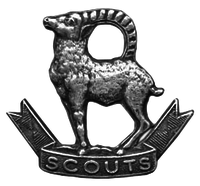Ladakh Scouts
| Ladakh Scouts | |
|---|---|
 Regimental Insignia | |
| Active | 1963–present |
| Country |
|
| Branch | Army |
| Type | Infantry |
| Role | Mountain warfare |
| Size | 5 battalions |
| Nickname(s) | Snow Warriors or Snow Tigers |
| War Cry | Ki Ki So So Lhargyalo (Victory to God). |
| Decorations | 1 Ashok Chakra, 11 Mahavir Chakra, 2 Kirti Chakra, 2 Ati Vishisht Seva Medals, 26 Vir Chakra, 6 Shaurya Chakra, 3 Yudh Seva Medals, 64 Sena Medals, 13 Vishisht Seva Medals, 13 Mentions-in-Dispatches, 67 Chief Of Army Staff commendation cards, 2 Jeevan Raksha Padak[1] |
| Insignia | |
| Insignia | Ibex Ibex, |
The Ladakh Scouts is an infantry regiment of the Indian Army, nicknamed the "Snow Warriors" or "Snow Tigers".[1] Specializing in mountain warfare, the regiment's primary role is to guard India's borders in the high altitude areas of the Ladakh region, as well as Jammu & Kashmir in general.
Raised by Colonel S.P. Salunke, the Ladakh Scouts were converted into an Army regiment in 2000. The Ladakh Scouts are recruited mainly from India's Ladakhi and Tibetan communities and are among the Indian Army's most decorated units. Its soldiers have been honored with over 300 gallantry awards and citations including one Ashok Chakra, ten Maha Vir Chakras and two Kirti Chakras.
History
In 1948, the "Nubra Guards" were raised from local Ladakhi warriors to patrol India's mountainous border in the Ladakh region.[2] In 1952, the Nubra Guards were merged as the 7th Battalion, Jammu & Kashmir Militia (which later became the Jammu and Kashmir Light Infantry). The 14th Battalion of the Militia was also raised from Ladakh in 1959.
On 1 June 1963, following the Sino-Indian War of 1962, the Ladakh Scouts was formed by spinning off the 7th and 14th Battalions of the J&K Militia. The primary role of the unit is reconnaissance and interdiction in the high-altitude border regions.
After 1999 Kargil war the Ladakh Scouts was reformed as a standard infantry regiment on 1 June 2000. Its parent regiment is the Jammu & Kashmir Rifles.
On 2 June 2013, it celebrated its Golden Jubilee.
Units
The regiment consists of 5 battalions with support personnel affiliated to other arms of the army.
Engagements
Indo-Pakistani Wars of 1965 and 1971
Units of the regiment have been deployed in combat in every major Indian operation since the Indo-Pakistan War of 1965. The Scouts received battle honours in the Western Theatre of the Indo-Pakistan War of 1971.
Operation Meghdoot
Units of the Ladakh Scouts were deployed with a battalion of the Kumaon Regiment to capture the Siachen Glacier in April 1984, as a part of Operation Meghdoot.[3]
Kargil War
The Ladakh Scouts were one of the first units to be deployed in action in Operation Vijay. Its units displayed exemplary gallantry and won numerous awards, including a Maha Vir Chakra for Major Sonam Wangchuk. The Scouts were awarded a Unit Citation for their gallantry during the battles of Point 5000 on night 05/06 July 1999, Dog Hill on the night 30 June/1 July, and Padma Go on the night 09/10 July 1999, in the Batalik Sector. The citation recognizes the unit's performance with distinction during Operation Vijay and display of exemplary valour and grit in the face of the enemy.[1]
Distinctions
Battle honours
- Turtuk, Indo-Pakistan War of 1971
Gallantry awards
Maha Vir Chakra Recipients:
- Colonel Sonam Wangchuk[4][5]
- Colonel Chewang Rinchen (with Bar)
Among the awards conferred on the soldiers of the Ladakh Scouts are:
- 1 Ashok Chakra
- 11 Maha Vir Chakras
- 2 Kirti Chakras
- 26 Vir Chakras
- 6 Shaurya Chakras
- 3 Yudh Seva Medals
- 2 Ati Vishisht Seva Medals
- 13 Vishisht Seva Medals
- 64 Sena Medals
- 13 Mentions-in-Dispatches
- 67 Chief Of Army Staff commendation cards
- 2 Jeevan Raksha Padaks
Winter sports
The Ladakh Scouts have produced notable winter sport athletes, including Jamyang Namgial and Tashi Lundup.
References
- 1 2 3 "Ladakh Scouts". GlobalSecurity.org.
- ↑ "Ladakh Scouts". Indian Army.
- ↑ "Operation Meghdoot". Indian Army.
- ↑ "Maj Sonam Wangchuk". Indian Army.
- ↑ "Major Sonam Wangchuk". Indian Army.
